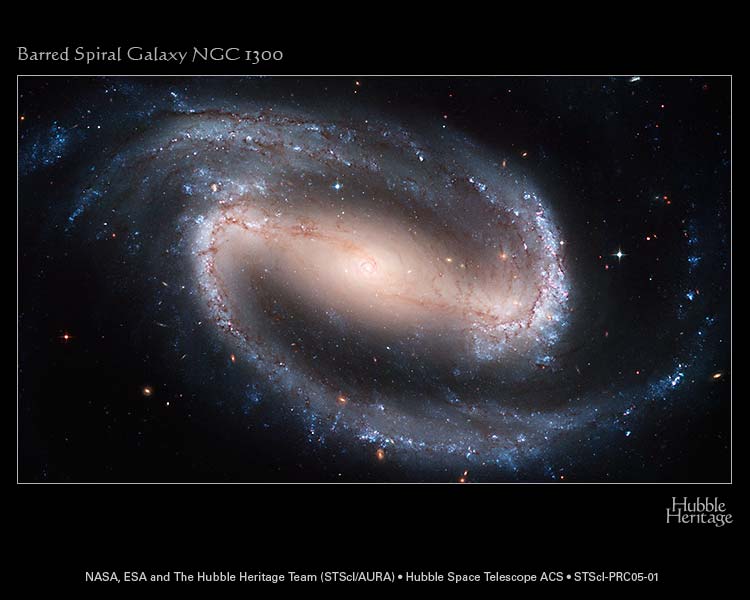







| BOOKS | F. A. Q. | ARTICLES | TALKS | ABOUT KEN | DONATE | BEYOND OUR KEN |
|---|
By Ken Croswell
Published on Science News (April 21, 2020)

The barred spiral galaxy NGC 1300 is one of the most spectacular galaxies in the heavens, but the dramatic bar that
pierces its heart produces few if any stars - even though the bar abounds with the raw material for creating them.
New computer simulations may explain the paradox in this and other galaxies with prominent bars. Galaxies form stars from clouds of interstellar gas and dust. But within the bar of NGC 1300, gas clouds smash together so fast they stir each other up and don't collapse into stars, researchers say April 3 in the Monthly Notices of the Royal Astronomical Society. The finding suggests that high-speed collisions between gas clouds also helped suppress star formation shortly after the big bang.
The brightest and most massive stars begin their lives with a blue hue, but they quickly die. If no new stars take their place, the population of stars as a whole eventually turns yellow-orange as less massive stars expand and become yellow, orange, and red giants.
Located about 68 million light-years from Earth in the constellation Eridanus, NGC 1300 resembles a backward letter S, with outwardly spiraling blue arms and a straight bar through the galaxy's center that is yellow-orange. That color scheme means gas and dust are spawning new stars in the arms, but few if any stars are arising in the 50,000 light-year-long bar. The Milky Way is also a barred spiral, but its bar is about two-thirds as long.
To understand why NGC 1300's bar doesn't sparkle with new stars, despite containing the gas and dust needed for the job, the researchers simulated the orbit of gas clouds around the galaxy's center. In most of the galaxy, the clouds follow fairly circular paths. But the gravitational attraction of all the stars in the bar yank on the clouds, making them swerve into the wrong lane and collide.
"We find that the cloud-cloud collision speed is very high, very fast, in the bar," says Yusuke Fujimoto, an astrophysicist at the Carnegie Institution for Science in Washington, D.C. There the clouds hit each other some 10 kilometers per second faster than elsewhere. Although a low-speed collision can mint new stars by making gas collapse, Fujimoto says a high-speed collision induces so much turbulence in the clouds that it ends their star-making careers.
The new results may also pertain to a galaxy closer to home. No one knows whether the Milky Way's bar has newborn stars, because astronomers can't see our own Galaxy from the outside. Still, if no new stars are arising in the Galactic bar, Fujimoto says the likely culprit is the high speed at which gas clouds there collide.
"This group has done a wonderful job," says Bruce Elmegreen, an astronomer at IBM’s Thomas J. Watson Research Center in Yorktown Heights, N.Y., who was not involved in the new work. "It's a very reasonable result." But he says other factors likely thwart star formation in NGC 1300's bar, too. For example, the gravitational pull of the bar's many stars can tear apart individual gas clouds before they are able to make new stars.
Fujimoto and his colleagues also speculate that high-speed collisions between gas clouds helped to impede the creation of stars shortly after the big bang, when the universe was smaller and more crowded. From observations of distant galaxies, astronomers know that star formation didn't peak until several billion years after the universe's birth.
Ken Croswell earned his Ph.D. in astronomy from Harvard University and is the author of The Alchemy of the Heavens and The Lives of Stars.
"An engaging account of the continuing discovery of our Galaxy...wonderful." --Owen Gingerich, The New York Times Book Review. See all reviews of The Alchemy of the Heavens here.
"A stellar picture of what we know or guess about those distant lights."--Kirkus. See all reviews of The Lives of Stars here.
| BOOKS | F. A. Q. | ARTICLES | TALKS | ABOUT KEN | DONATE | BEYOND OUR KEN |
|---|